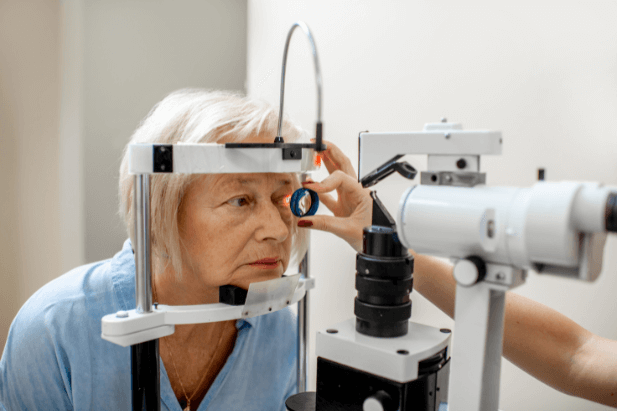
Before the 19th century, a diagnosis of glaucoma meant you could anticipate slowly losing your eyesight. Physicians of that era developed surgical and topical treatments to help ease the symptoms. These days, Selective Laser Trabeculoplasty (SLT) and Minimally Invasive Glaucoma Surgery (MIGS) are two types of open-angle glaucoma surgery that can stop the disease from progressing. Glaucoma implant surgery is also an option for people with glaucoma. Knowing your options regarding glaucoma surgery is the first step to preventing further damage to your eyesight.
What is Glaucoma?
Glaucoma is the name for several eye diseases that lead to impaired vision and blindness through damage to the optic nerve, a large nerve at the back of the eye. According to the National Eye Institute, there is no cure for glaucoma. It is the second-most common cause of blindness in the United States. Still, if it is caught early with a comprehensive eye exam, treatment can prevent further damage and preserve your vision.
What Kinds of Glaucoma Exist?
Eye doctors recognize four kinds of glaucoma. They are open-angle glaucoma, angle-closure glaucoma (also called closed-angle glaucoma), congenital glaucoma, and secondary glaucoma. Open-angle glaucoma is the most common form of glaucoma, in which the fluid pressure in the eye increases slowly. Doctors are not sure why open-angle glaucoma occurs. Secondary glaucoma is caused by another illness, such as diabetes. Congenital glaucoma occurs in babies and is present at birth. Closed-angle glaucoma is a sudden condition that requires immediate treatment.
What Treatments Exist for Glaucoma?
Glaucoma may be treated with various medications (often eye drops), laser therapy, and surgery. Treatment for glaucoma should begin as soon as the diagnosis is made. Your eyesight will not be restored by treatment, but it will prevent further decline.
Non-Surgical Treatments
Glaucoma is often treated with medical eye drops. Some eye drops help fluid drain out of your eye, which lowers the pressure in your eye. Other kinds of eye drops work by making your eyes make less fluid. Eye drops prescribed to glaucoma patients must be used daily and sometimes taken twice daily.
Laser Treatment may be useful in treating glaucoma in certain cases. Your eye doctor may do this in his or her office. It helps relieve eye pressure by encouraging fluid outflow from the eye. Trabeculoplasty is a laser procedure used to treat open-angle glaucoma. Other forms of glaucoma may also be treated with laser surgery.
How does glaucoma laser therapy work?
If your doctor recommends laser therapy, they will:
- Put some eye drops in your eye to numb it.
- Using a magnifying lens, put a laser (a concentrated beam of light) into your eye.
- Use the laser to aid in fluid drainage from your eye.
You may experience brief yet intense bursts of green or red light during the procedure. During treatment, most patients report feeling little to no pain or discomfort. Your doctor may treat both eyes at once if you have bilateral glaucoma, or they may treat one eye and arrange treatment for the other later.
Surgical Treatments
Presently, there are three main types of surgery used to treat open-angle glaucoma. They are trabeculectomy, glaucoma implant surgery, and minimally-invasive glaucoma surgery.
Trabeculectomy
Open-angle glaucoma is the most common cause of this operation. It takes less than an hour and is performed in a hospital setting.
The surgeon will make a small incision near the cornea of your eye. The incision will be made discreetly beneath your lower eyelid. This slit lets the eye’s excess fluid drain, reducing intraocular pressure.
You will be awake throughout this procedure but will be given medication to help you relax and prevent pain. In most cases, you can go home the same day.
Glaucoma implant surgery
Several forms of glaucoma, including congenital, neovascular, and injury-induced glaucoma, are treatable with this surgical procedure. It takes around a couple of hours to complete in a hospital setting.
Surgeons perform this procedure by inserting a thin tube (shunt) into the white of your eye. The tube aids in draining excess fluid from the eye, reducing intraocular pressure.
You will be awake throughout this procedure but will be given medication to help you relax and prevent pain. Day-to-day discharge is the norm.
Minimally-invasive glaucoma surgery
Minimally invasive glaucoma surgery (MIGS) techniques have been developed to treat patients sooner and more safely than traditional surgery. Complications are less likely to occur during a MIGS operation because of microsurgical equipment and devices and smaller incisions. These operations are safer, but they aren’t quite as effective, according to glaucoma.org.
There are many different processes in MIGS devices and methods. Some aid in evacuating fluid from the eye, while others transport that fluid away from it. Some MIGS treatments must be performed with cataract surgery, while others may be done independently.
The requirement for blood pressure medication may be reduced with either cataract surgery or a combination of cataract surgery and laser intraocular lens implantation (MIGS). Cataract surgery takes a little longer when a MIGS device is implanted.
The MIGS family of diagnostic tools and surgical procedures is organized as follows:
- Miniature trabeculectomy methods include inserting microscopic tubes into the eye to facilitate fluid drainage from the anterior chamber to the subconjunctival space. The XEN Gel Stent, which the FDA has approved, and the PRESERFLO (previously InnFocus) MicroShunt, which has been approved in countries other than the United States, can be used.
- Angle-based surgeries: These operations use specialized techniques and devices to alter the ocular drainage canals (trabecular meshwork, Schlemm’s canal, and collecting channels) and enhance fluid outflow from the eye. These techniques include expanding the Schlemm’s canal and collector channels with a gel, cutting through the trabecular meshwork, and bypassing the trabecular meshwork with a stent. Improving fluid outflow from the eye is possible by combining several angle-based MIGS treatments.
When Does Someone Need Glaucoma Surgery?
If a patient has tried non-surgical glaucoma treatment options like eye drops or laser treatments without success, they may be recommended to have glaucoma surgery. Also, if the patient has advanced glaucoma, surgery may be recommended to stop the progression of vision loss. The third reason someone may need glaucoma surgery is if they don’t like or can’t use eye drops.
What Are The Benefits of Open-Angle Glaucoma Surgery?
Surgery for glaucoma has a high success rate in reducing intraocular pressure and protecting the optic nerve. It may be required to stabilize your eye pressure and prevent further visual loss from glaucoma.
Schedule a Consultation with the Atlanta Vision Institute If you have been diagnosed with open-angle glaucoma, contact us to schedule a consultation and discover your surgical options. We have multiple locations staffed with skilled ophthalmologists who can perform your surgery and help you take control of your vision health.

Please Take Our LASIK or Cataract Surgery Quiz
Take our vision quiz to find out if you qualify for LASIK or cataract surgery!


